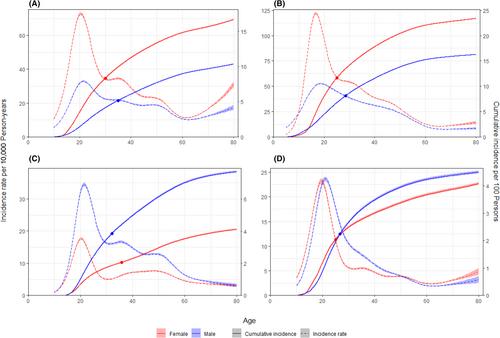A comprehensive analysis of age of onset and cumulative incidence of mental disorders: A Danish register study
Abstract
Background
The age of onset (AOO), incidence and cumulative incidence of mental disorders are critical epidemiological measures, providing essential insights into the development and course of these disorders across the lifespan. This study aims to provide up-to-date estimates of the AOO, age-specific incidence, and cumulative incidence for a comprehensive range of mental disorders using data from Danish registers.
Methods
We conducted a follow-up study encompassing all Danish residents from January 1, 2004, to December 31, 2021, totaling 91,613,465 person-years. Data were sourced from the Danish Psychiatric Central Research Register, identifying individuals treated for various mental disorders in psychiatric hospitals, outpatient departments, and accident/emergency departments, that is, treated in secondary care settings. We investigated specific categories of mental disorders, including substance abuse disorders, schizophrenia, mood disorders, anxiety, eating disorders, borderline personality disorders, intellectual disabilities, pervasive developmental disorders, and behavioral and emotional disorders. Age-sex-specific incidence rates were estimated using Poisson generalized linear models, and cumulative incidence was calculated using Aalen–Johansen's competing risks model. The study provides estimates of AOO, incidence, and cumulative incidence for various mental disorders, including their age and sex distributions.
Results
The cumulative incidence by age 80 years for any mental disorder was 30.72% (95% confidence interval: 30.62%–30.83%) for males and 34.46% (34.35%–34.57%) for females. The most common types of mental disorders were anxiety-related disorders 16.27% (16.19%–16.36%) for males and 23.39% (23.29%–23.50%) for females, and followed by mood disorder 10.34% (10.27%–10.41%) for males and 16.67% (16.58%–16.77%) for females. For those who develop mental disorder, half will have developed their disorder by approximately age 22 years (median and interquartile range: males 21.37 (11.85–36.00); females 22.55 (16.31–36.08)).
Conclusions
Approximately one in three individuals will seek treatment for at least one mental disorder in a secondary care setting by age 80. Given that half of these individuals develop mental disorders before age 22, it is crucial to tailor service planning to meet the specific needs of young individuals. Web-based interactive data-visualization tools are provided for clinical utility.


 求助内容:
求助内容: 应助结果提醒方式:
应助结果提醒方式:


